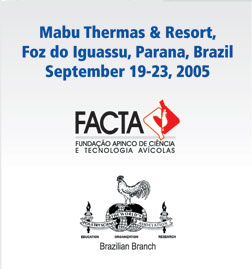Contributed Papers: Oral Presentations
Chemotherapy |
The impact of
the crowding effect of chicken Eimeria on the efficacy
of anticoccidials: a hypothesis
Maarten De Gussem
Janssen Animal Health
mdgussem@janbe.jnj.com
Chemicals, such
as diclazuril (Clinacoxâ), are often used to
reduce coccidial infection pressure (IP). Oocyst output
(OO) and lesion scores (LS) are used to evaluate levels
of IP. Remarkably, without indications of resistance,
OO and/or LS are not always reduced when introducing
an anticoccidial in a programme.
A crowding effect
(CE) may explain certain parasite-host relationships.
It can be defined as a lowered fecundity whenever
the number of infective parasites exceeds a certain
threshold, which may apply to a population of hosts
or an individual. With Eimeria, CE reducing OO has
been demonstrated by several authors.
Several
factors may account for CE
The most striking applies when a heavy infection
causes death of the host before oocysts are produced.
Heavy oocyst
doses may exceed host-cell availability. In vivo,
sporozoites of apicomplexans such as Eimeria spp.
do not invade enterocytes in all segments of the gut.
Interaction between proteins on the parasite and on
the host-cell surface may explain different infection
sites of various species of Eimeria. Cell-age dependent
expression of host-cell proteins may significantly
reduce the number of specific cells available for
invasion. Availability of host-cells might therefore
be more limited than generally assumed. At a high
IP, host-cells may be destroyed before development
of the parasite is completed, reducing the number
of oocysts produced. Furthermore, if a CE exerts an
early influence on the life cycle, it may cause diminution
of lesions or pathology, if these are caused by stages
occurring later in the life-cycle.
Another factor
may be the more rapid response of the immune system
with higher infection levels.
Causes of CE
may differ for various Eimeria species. The effects
of CE (altered OO, LS or bird performance) will differ
with the stage of the life-cycle impacted by CE.
Whatever cause
or effects, reducing the infectious dose per chicken
from levels above the CE threshold might cause a “reverse-CE”,
increasing OO and LS, or even decreasing performance
of birds. Reverse-CE can explain why anticoccidials
do not always reduce LS and OO when just introduced
in a programme, while effectively reducing IP. A false
impression of drug-resistance may result.
The relevance
of CE for poultry producers has never been fully investigated.
Further evaluation of the relation between CE and
anticoccidial programmes is therefore required.
